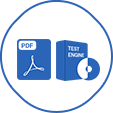Last Update 11 hours ago Total Questions : 50
The Workday Pro Prism Analytics Exam content is now fully updated, with all current exam questions added 11 hours ago. Deciding to include Workday-Prism-Analytics practice exam questions in your study plan goes far beyond basic test preparation.
You'll find that our Workday-Prism-Analytics exam questions frequently feature detailed scenarios and practical problem-solving exercises that directly mirror industry challenges. Engaging with these Workday-Prism-Analytics sample sets allows you to effectively manage your time and pace yourself, giving you the ability to finish any Workday Pro Prism Analytics Exam practice test comfortably within the allotted time.
A Prism data administrator is ready to create a Prism data source. As data is updated in Prism, the goal is to update the data in the Prism data source concurrently, enabling immediate incremental updates. How should the administrator create the Prism data source?
You created a derived dataset that imports data from a table, which will become your Stage 1. What can you add to this dataset?
The final derived dataset in a Prism pipeline is complete and ready to publish. What should be done prior to publishing?
When should a Prism configurator leverage advanced filter logic over basic filter logic?
What is a feature of using an sFTP connection on a data change task?
A custom report uses your recently published Prism data source, but you noticed a minor error in the published data. You need to delete the published rows to fix it. What happens to your custom report?
A Prism data writer needs to create a new Prism calculated field on a derived dataset using the CASE function. When creating a calculated field, what symbol do you use to view a list of fields that you can select from in the dataset?

